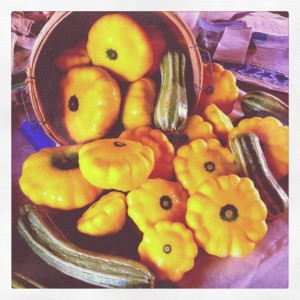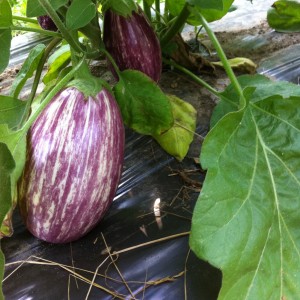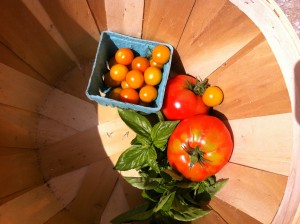We sell most of our produce through our 16 family CSA, but also will be attending the Carlisle Farmer’s Market (Saturday mornings 8–12am) periodically throughout the summer.
This piece of land we have come to farm has been very productive. Partly because it abuts a wet meadow and because it’s aspect is southeast. It hadn’t been farmed for more than 20 years and even then it was likely just animals, not vegetables. It’s deep and organic in nature, lots of decomposing plant material, as opposed to mineral (rocky or sandy) soils. It holds water like a sponge , consequently we haven’t had to rely on irrigation, thus far.
We do most of the work in the garden by hand, aided by many useful tools designed for the small market gardner. Working the garden by hand allows us to grow much more intensively in a small space, it keeps the soil from being compacted by tractors and it decreases our reliance on fossil fuels.
Our proximity to the wetland brings in insects, dragonflies and butterflies. Our tomato trellis last year may not have always been strong enough to handle the weight of the many large fruits, but the trellis did support the landing site for many fledgling barn swallow clutches out on their first flight. Bluebirds, too, used the wooden posts to hunt for early spring bugs.
The electric fence that surrounds both the vegetable patches, the pigs and the meat chickens protects our charges from animals that would also like a local source of fresh organically grown food. Dave did his homework on the best fence plan for our site. Our fences aren’t high (30″) but they are baited monthly with peanut butter. Apparently, most animals like peanut butter and will go for the PB before they jump in for the animals or vege. But when they lick the PB on the foil, hanging over the electric fence, they get a shocking response! Happens once, they don’t come near again.
We have experimented with walkway management to lessen weed pressure and increase soil fertility. Some rows are cardboard from the bike shop (nice big pieces) with old hay from Concord DWP projects on top. We planted white clover in others and then mowed when weeds were topping the clover. That gives clover the advantage and it takes over. We bring in compost for seeding and transplanting in the rows from a local farm and amendments (rock dust, mycorrhizal organisms and seaweed mixes) from away, although we’re trying this year to work with compost from
the horses to make it garden ready. We decided to use some plastic as mulch in the rows (there are those fossil fuels, sneaking back in). The area closest to the wetland would have been weed hell if it were not for black plastic mulch. That’s under the tomatoes, eggplants, peppers and squash. They love the extra heat and moisture retention plastic offers. We also use row cover, which is spun plastic. That protects our plants from pests without using pesticides.
We are growing our plants using organic methods, however, we are not certified organic. Organic certification policies are very difficult for a small farm to adhere to. They are lengthy, expensive and the record keeping requirements are over the top. In addition, we feel as if it is more important to try and create a closed loop on the farm and minimize waste, than it is to adhere to a government standard. For example, we want to be able to use the horse manure generated on the farm, even though all the horses are not fed organic grain. But you can rest assured that we don’t use any chemical (man-made) fertilizers, herbicides or pesticides on the farm, and never will.
It would be better to describe our farm as eco-ganic. Eco-ganic is defined by Potomac Vegetable Farm as a process by which a farm maintains rich organic soils, full of beneficial microbes, to provide the crops with sufficient nutrients and a healthy environment. The farm can’t use any synthetic fertilizers or pesticides, they rotate crops, grow many different kinds of crops, and use timely and appropriate practices to try to minimize insect and disease damage. The idea is to manage the soil and cultivate the crops in ways that will allow the land to continue to be productive now and into the future. We like this label the best. It’s about the mind blowing interaction of so many parts (soils, insects and animals, water, sun) coming together and undertaking a amazing cycle of growth, death, decomposition and regrowth and, we as participants, help perpetuate that cycle into the future.
All three of us have been committed to maintaining the healthiest environment for our products, whether they be plant or animal. We want to eat responsibly grown food, food that is high in nutrients and free of damaging chemicals. Black Brook Farm Growers may not have the organic stamp of approval from big business, but we are bringing to market products that are as good or better for our customers than what they buy from most other currently available food sources.


